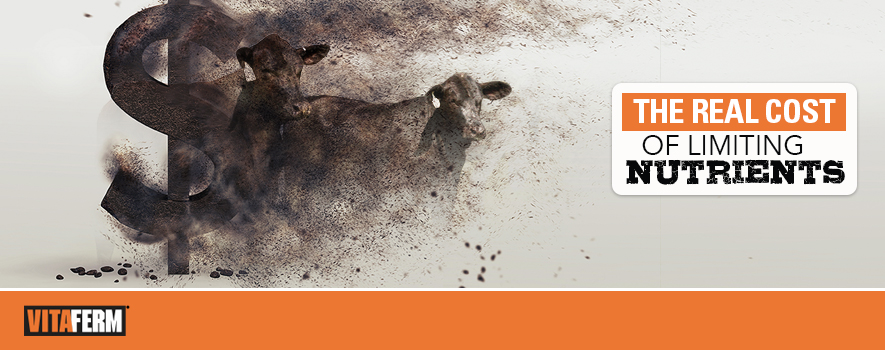
– Dr. Les Anderson, Beef Extension Specialists, University of Kentucky
Fall is rapidly approaching, and all cow-calf producers need to access the body condition score, or BCS of their herd. Spring-calving cows are weaned off and the fall is the most economical time to put weight back on. Now is also a key time to manage BCS score in fall-calving cows. Most realize the link between body condition score and reproductive rate, but what is the economic impact of allowing BCS to decline? Each year producers face the decision of how much money should I put into my cows? Can I afford to feed them? So, what is the cost of letting your cows get thin? What is more cost effective; reducing costs by limiting nutrition to your cows and living with reduced reproductive performance or feeding your cows to perform?
Let’s use a real-world example. The farm we will discuss had 100 fall-calving cows. The average body weight of these cows was about 1300 lbs. at a BCS of 5. These cows calved in good condition, averaging a BCS of a nearly 6. However, lack of rain resulted in limited pastures and the producer began to feed hay approximately September 1st, which coincided with the onset of calving. The hay was below average in quality (TDN of 48, CP of 7%). Money was tight for this operation, so they made the decision NOT to supplement these cows. Making the assumption that these cows were average lactating cows and that they would consume about 27 pounds of hay (as fed) daily, the hay provided only 82% of their maintenance energy needs and would result in a loss of one BCS in about 57 days. This producer decided to synchronize and AI his cows. On November 21st when the timed AI was performed, the average BCS had decreased, as predicted above, averaging a strong 4. Remember each BCS equals about 75 pounds so these cows were losing weight rapidly. After the insemination, the bulls were turned out for 60 days then removed. The cows were preg-checked about 90 days after the insemination and their average BCS was a weak 4 so the cows likely lost another 30 pounds or so of body weight. Reproductive performance was terrible as only 29 conceived to the AI, 31 conceived via natural service, and 40 were OPEN!
This example may seem exaggerated, but this scenario actually occurred on a farm and is a real-world example of improperly managing body condition score. The question then becomes which was the more economical management scheme; no supplementation and reduced reproduction or supplementation to meet nutrient needs. To help determine this let’s first look at our losses. In the above scenario, 40 cows were examined as open. Of these, let’s assume 7 would have been open regardless so 33 calves were lost due to the reduced input management. Let’s say these 33 calves (17 steers, 16 heifers) would have weaned at 525 pounds (550 for steers, 500 for heifers) so we lost 17,350 pounds of product.
Allowing the cows to lose weight likely also increased the cost per AI pregnancy. Our data from thousands of properly conditioned cows suggested that typically we achieve a 60% conception rate to AI and 92-93% overall pregnancy rate. The cost per cow to perform the insemination totaled approximately $40 ($10 CIDR, $13 GnRH & PG, $5 technician, $12 semen) per cow or $4,000 total. The reproductive failure basically doubled the cost per pregnancy from $67 ($40/.60) to $138 ($40/.29) making it impossible for this operation to recoup the cost of the AI.
What would it cost to supplement these cows to maintain their weight for this period of time? To meet their nutrient needs, these cows would need about 12 pounds of our soyhull/corn gluten supplement mixed at a ratio of 2:1 assuming a 1:1 substitution of supplement for hay intake. The cost of our supplement averaged $150 per ton for the feeding period which lasted from September 1st to bull removal on February 1st or 123 days. So the cost of supplementation would be about $11,070 ($.075 per pound x 12 pounds x 123 days x 100 cows = $11,070). If you back calculate, the break-even weaning weight for this level of supplementation is slightly less than 350 pounds.
So, what is cheaper? What if we would have separated the thin cows and fed them to match their nutrient needs? What if we would have taken the $4,000 we used for the AI and used it to purchase supplement? What if we had cut our hay earlier so that the TDN exceeded 55% (nutrient needs of the lactating cow) even though we would have made less hay?
We could ask several more questions. We could consider several more options. The decision to supplement is pretty easy math.
A note from BioZyme®:
BioZyme offers a full line of products that can help your cows reach optimal body condition score come breeding season. Amaferm®, is a prebiotic designed to enhance digestibility by amplifying the nutrient supply for maximum performance. It is research-proven to increase intake, digestion and absorption.
. Cumulatively, these key benefits will help your cattle maintain or achieve that ideal BCS needed to maximize reproductive efficiency.
This coupled with the top-notch nutrition found in all of our mineral and protein supplements, producers can rest assured that their cattle are receiving all the vital vitamins, minerals and trace minerals needed to get their cows bred on time and keep them bred.
Our on-staff nutritionists can also work with you to create the ideal ration for your herd at no cost. It is no secret that good nutrition creates “performance that pays.”
For more information about our nutrition services, click here.


